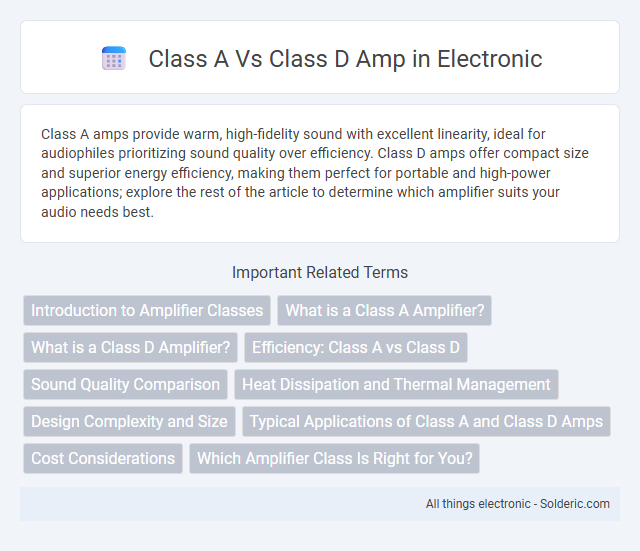Class A amps provide warm, high-fidelity sound with excellent linearity, ideal for audiophiles prioritizing sound quality over efficiency. Class D amps offer compact size and superior energy efficiency, making them perfect for portable and high-power applications; explore the rest of the article to determine which amplifier suits your audio needs best.
Comparison Table
| Feature | Class A Amplifier | Class D Amplifier |
|---|---|---|
| Operation | Continuous conduction; output transistors always on | Switching operation; transistors toggle on/off rapidly |
| Efficiency | Low (20-30%) | High (80-95%) |
| Sound Quality | High fidelity, low distortion | Good fidelity; may have switching noise |
| Heat Generation | High heat dissipation required | Minimal heat generation |
| Size & Weight | Large and heavy due to heat sinks | Compact and lightweight |
| Applications | High-end audio, audiophile systems | Portable devices, car audio, home theaters |
| Cost | Generally higher | Generally lower |
Introduction to Amplifier Classes
Class A amplifiers operate with continuous conduction, providing high-fidelity sound and low distortion by running their output transistors at full power. Class D amplifiers, known as switching amps, use pulse-width modulation to achieve greater efficiency and cooler operation by rapidly switching transistors on and off. Understanding the difference helps you choose between premium audio quality and energy-efficient performance for your sound system.
What is a Class A Amplifier?
A Class A amplifier operates by continuously conducting current through its output transistors, ensuring minimal distortion and delivering a high-quality, warm sound favored by audiophiles. Unlike Class D amps that use switching technology for efficiency, Class A amps prioritize linearity and audio fidelity at the expense of higher power consumption and heat generation. Your choice between Class A and Class D amps should consider whether sound purity or energy efficiency is more important to your audio setup.
What is a Class D Amplifier?
A Class D amplifier is a type of audio amplifier that uses pulse-width modulation (PWM) to convert the input signal into a series of high-frequency pulses, resulting in high efficiency and reduced heat generation. Unlike Class A amplifiers, which operate their output transistors in the linear region, Class D amplifiers operate as switches, significantly improving power efficiency to often above 90%. This makes Class D amplifiers ideal for applications requiring lightweight, compact designs with high power output, such as portable sound systems and car audio.
Efficiency: Class A vs Class D
Class D amplifiers achieve higher efficiency, often exceeding 90%, by using pulse-width modulation to switch output transistors fully on or off, minimizing energy loss as heat. In contrast, Class A amplifiers typically operate with efficiency below 30% because their output transistors conduct continuously, resulting in significant power dissipation. This fundamental difference makes Class D amps ideal for applications requiring compact designs and low heat generation, while Class A amps prioritize audio fidelity despite inefficiency.
Sound Quality Comparison
Class A amplifiers deliver superior sound quality characterized by low distortion and high linearity, providing a warm, natural, and detailed audio experience favored by audiophiles. In contrast, Class D amplifiers, while highly efficient and compact, may produce higher distortion and noise levels, though advancements in technology have significantly improved their sound fidelity. The choice between Class A and Class D amps often depends on the listener's preference for pristine audio reproduction versus energy efficiency and size.
Heat Dissipation and Thermal Management
Class A amplifiers generate significant heat due to continuous current flow, requiring robust heat sinks and active cooling systems to maintain optimal thermal management. Class D amplifiers operate with high efficiency, producing minimal heat and often eliminating the need for large heat dissipation components. Your choice between Class A and Class D amps will impact the size, cooling requirements, and energy efficiency of your audio setup.
Design Complexity and Size
Class A amplifiers feature simple design with minimal components, resulting in larger size and substantial heat dissipation due to continuous high power consumption. Class D amplifiers employ advanced switching technology with complex circuitry, enabling compact, lightweight designs and significantly improved efficiency by operating transistors as digital switches. The intricate design of Class D enables miniaturization and reduced thermal output, making them ideal for portable and space-constrained audio applications.
Typical Applications of Class A and Class D Amps
Class A amplifiers are typically used in high-fidelity audio systems and professional studio equipment, where sound quality and low distortion are critical. Class D amplifiers are favored in portable devices, car audio systems, and sound reinforcement applications due to their high efficiency and compact size. Your choice depends on whether audio purity or energy efficiency matters most for your application.
Cost Considerations
Class D amplifiers typically offer higher efficiency and lower production costs compared to Class A amplifiers, making them more budget-friendly options for consumers. The simpler circuitry and reduced heat dissipation in Class D amps further decrease the need for expensive cooling solutions, contributing to overall cost savings. Class A amplifiers, while providing superior sound quality, often come with higher manufacturing and operating costs due to their complex design and significant energy consumption.
Which Amplifier Class Is Right for You?
Class A amplifiers deliver high-fidelity sound with minimal distortion, making them ideal for audiophiles who prioritize audio quality over efficiency. Class D amplifiers offer superior energy efficiency and compact designs, perfect for portable setups and systems requiring lower power consumption. Choosing between Class A and Class D depends on your preference for sound purity versus efficiency and form factor.
Class A vs Class D amp Infographic

 solderic.com
solderic.com